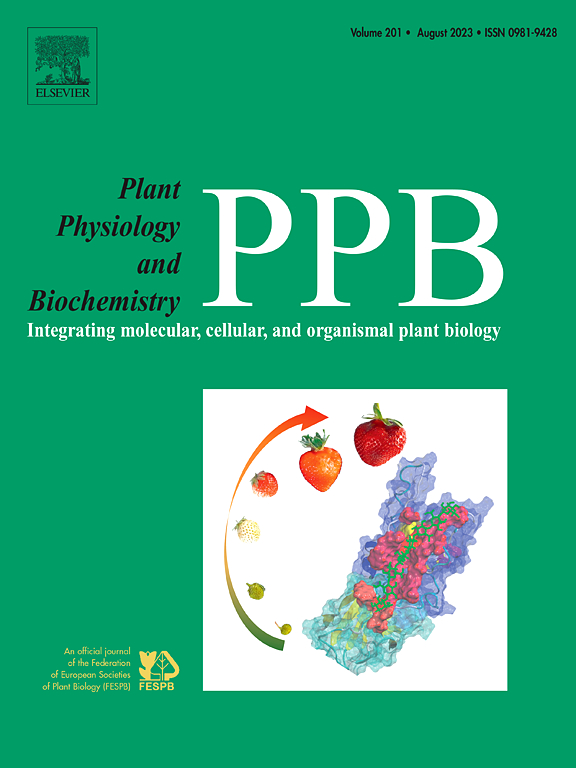ZAT17-PRL1模块参与拟南芥miRNA的合成
IF 5.7
2区 生物学
Q1 PLANT SCIENCES
引用次数: 0
摘要
MicroRNAs (miRNAs)通过转录后影响靶mrna的表达或抑制靶mrna的翻译,从而控制植物的生长和胁迫反应。多效性调控位点1 (PRL1)在miRNA合成过程中起着至关重要的作用。然而,PRL1下游信号的调节因子在很大程度上仍然未知。先前有研究报道,sup8 (prl1-2的抑制因子)可以部分补偿prl1-2突变体的发育和镉(Cd)敏感性。sup8的突变基因编码c2h2型锌指蛋白ZAT17。我们的研究发现sup8修复了prl1-2中miRNA表达的缺陷。通过RNA-seq分析,我们发现ZAT17负向调节特定MIR基因的转录,并可能通过调节特定mirna的积累水平影响特定的生物过程,如淀粉和蔗糖代谢、昼夜节律、甘油脂代谢和氨基酸代谢。此外,我们表征了prl1-2中MIR171b和MIR172b的选择性剪接(AS)缺陷,这些缺陷被ZAT17修复。与ZAT17参与miRNA的产生一致,我们发现ZAT17与pri-miRNA Dicer复合物的组分相互作用。这些发现拓宽了我们对miRNA生物合成途径的理解,并为旨在提高植物生长和抗逆性的育种计划提供了有希望的候选靶点。本文章由计算机程序翻译,如有差异,请以英文原文为准。
The ZAT17-PRL1 module engages in the miRNA synthesis in Arabidopsis
MicroRNAs (miRNAs) affect the expression of target mRNAs post-transcriptionally or inhibit their translation, thus controlling plant growth and stress response. Pleiotropic Regulatory Locus 1 (PRL1) plays a crucial role in the process of miRNA synthesis. However, the regulators of PRL1 downstream signaling remain largely unknown. A previous study reported that sup8 (suppressor of prl1-2) can partially compensate for the development and cadmium (Cd) sensitivity of prl1-2 mutant. The mutant gene in sup8 encodes C2H2-type zinc finger protein ZAT17. Our research revealed that sup8 restored the defect in miRNA expression in prl1-2. Through RNA-seq analysis, we discovered that ZAT17 negatively modulated the transcription of specific MIR genes and might affect specific biological processes, such as starch and sucrose metabolism, circadian rhythm, glycerolipid metabolism, and amino acid metabolism, via modulating the accumulation levels of particular miRNAs. Furthermore, we characterized the alternative splicing (AS) defects of MIR171b and MIR172b in prl1-2 that were restored by ZAT17. Consistent with ZAT17's involvement in miRNA production, we found that ZAT17 interacts with the components of the pri-miRNA Dicer complex. These findings broaden our understanding of miRNA biosynthetic pathways and provide promising candidate targets for breeding programs aimed at enhancing plant growth and stress tolerance.
求助全文
通过发布文献求助,成功后即可免费获取论文全文。
去求助
来源期刊
CiteScore
11.10
自引率
3.10%
发文量
410
审稿时长
33 days
期刊介绍:
Plant Physiology and Biochemistry publishes original theoretical, experimental and technical contributions in the various fields of plant physiology (biochemistry, physiology, structure, genetics, plant-microbe interactions, etc.) at diverse levels of integration (molecular, subcellular, cellular, organ, whole plant, environmental). Opinions expressed in the journal are the sole responsibility of the authors and publication does not imply the editors'' agreement.
Manuscripts describing molecular-genetic and/or gene expression data that are not integrated with biochemical analysis and/or actual measurements of plant physiological processes are not suitable for PPB. Also "Omics" studies (transcriptomics, proteomics, metabolomics, etc.) reporting descriptive analysis without an element of functional validation assays, will not be considered. Similarly, applied agronomic or phytochemical studies that generate no new, fundamental insights in plant physiological and/or biochemical processes are not suitable for publication in PPB.
Plant Physiology and Biochemistry publishes several types of articles: Reviews, Papers and Short Papers. Articles for Reviews are either invited by the editor or proposed by the authors for the editor''s prior agreement. Reviews should not exceed 40 typewritten pages and Short Papers no more than approximately 8 typewritten pages. The fundamental character of Plant Physiology and Biochemistry remains that of a journal for original results.

 求助内容:
求助内容: 应助结果提醒方式:
应助结果提醒方式:


